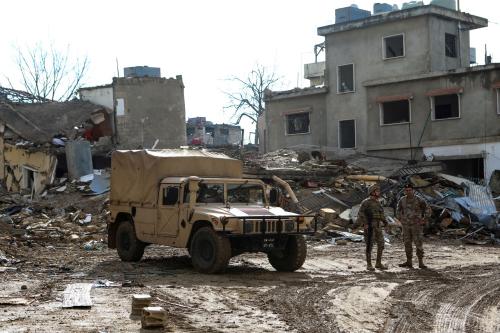In its 230 years of independence, the United States has faced a wide range of military opponents. We started of course with the British; the North fought the slave-holding South in the Civil War; we fought native Americans as well as the Mexicans and Spanish during other parts of the 19th century; we opposed Kaiser Wilhelm’s Germany in World War I and Adolf Hitler as well as the Japanese in World War II; during the Cold War we waged war against North Korean, Chinese, and Vietnamese communists.
Against this historical backdrop, two facts stand out about our collection of enemies in Iraq, with a particular focus on the ex-Ba’athists and the terrorists who produced the bulk of the violence over the conflict’s first three years. First, they are a small group relative to the population within which they are found. And second, even by the standards of our nation’s past enemies, they are a despicable lot.
Remembering these two simple yet often overlooked facts is crucial for understanding the kind of war we fight today. Often, we fail to depict the conflict in such terms. The Bush administration conjures up the image of a strong global al Qaeda movement to motivate America’s support for the war.
By contrast, many Americans who oppose our presence in Iraq focus on sectarian hatreds that have come to affect millions of Iraqis. While there is an element of truth to each of these images of our challenge in Iraq, neither is the most accurate way to understand the war.
Consider first the numbers of those fighting in Iraq. Throughout the first three years of the Iraq war, Brookings’ estimates of the size of the resistance, based largely on CENTCOM data, ranged from 15,000 to 20,000 fighters. Only about 1,000 to 2,000 al Qaeda were typically in Iraq. Yet these individuals, altogether representing less than 0.1 percent of Iraq’s population, have used sabotage and terror and assassination so effectively as to prevent Iraqi economic recovery, the formation of a strong government, or a sense of hopefulness among the Iraqi population.
Admittedly, guerrilla movements are often relatively small, but Iraq’s insurgency has been particularly so. Its al Qaeda element, responsible for most of the suicide attacks such as those that terrorized Baghdad April 18, has been downright tiny.
As for the character of our enemies, they have been unusually ruthless and nihilistic. This is not meant as a trite, nationalistic but a comparative comment. Looking back historically, at least some of our enemies can be respected, albeit begrudgingly.
Certainly the British were not systematic human-rights abusers or mass murderers, even if they taxed without representation two centuries ago. Many of our enemies of the 19th century were groups or countries we fought to gain land and resources, not to combat a bankrupt or threatening ideology. Without wanting to push the point too far, while many of our 20th century foes were indeed horrendous, some like the Viet Cong at least claimed to offer a vision of a better society, or had legitimate anticolonial origins, or otherwise possessed at least some redeeming attributes.
Not so al Qaeda and former Ba’athist extremists in Iraq. Their only purpose in violence has been to tear down, not to build up an alternative vision they genuinely support. They are ruthless killers who often seem to kill just for the pleasure of it. To put it somewhat more precisely, ex-Saddamists want to restore a Sunni autocracy, and al Qaeda wants to return the region to the seventh century and is willing to kill anybody along the way to do so. There is no merit in either vision according to any serious cultural or moral code in the world today.
The car bombs April 18 in Baghdad prove the point about our small, terrible enemy. How many people were involved? Five to drive the cars, maybe a couple dozen in all to reconnoiter routes and prepare the vehicles. Yet this number of people gives the impression of an Iraq in chaos with sectarian war rampant.
My point is not to mimic the Bush administration or others who wish to say the surge is clearly working, save for a few bad apples. To date, I do not believe it is working. Two hundred dead is two hundred dead, and other indicators in Iraq suggest at best modest improvement in certain subcategories of violence with an overall picture that has changed very little from January. This kind of violence, if it continues, will prevent us from succeeding and force a new strategy for Iraq (such as my own preference, soft partition into three autonomous regions, including a program to help people relocate to places they will be safer).
But for those who would give up on this war, it is important to bear in mind what that would mean—and who would be prevailing if we indeed conceded the fight. In this regard, I disagree with the characterization of the war reportedly offered by Senate Majority Leader Harry Reid in his recent meeting with President Bush. Understandably fed up with the violence in Iraq, and understandably critical of the many mistakes made by this administration over the years in prosecuting the war, Mr. Reid nonetheless went too far. He told Mr. Bush that the president’s concern over his legacy should not lead him to keep the nation engaged in a losing war.
Indeed, it is true that Mr. Bush’s legacy will suffer enormously if we lose in Iraq, a point the president surely appreciates; my view is that this administration is already guaranteed to have at best a mediocre place in America’s historical annals given its poor handling of Iraq.
However, even if Mr. Bush began this war, America as a nation is now fighting it. And Americans, along with our allies and with the overwhelming majority of Iraqis who want a peaceful life, will be the ones to lose it to a collection of thugs and ruthless killers if we withdraw. National pride should not of course keep us in a war we have indeed lost. But we should give the surge a chance, and consider a number of “Plan Bs” if it fails, before giving up this important fight to this heinous foe in this crucial part of the world.
The Brookings Institution is committed to quality, independence, and impact.
We are supported by a diverse array of funders. In line with our values and policies, each Brookings publication represents the sole views of its author(s).



Commentary
Fighting A Ruthless Foe in Iraq
April 24, 2007